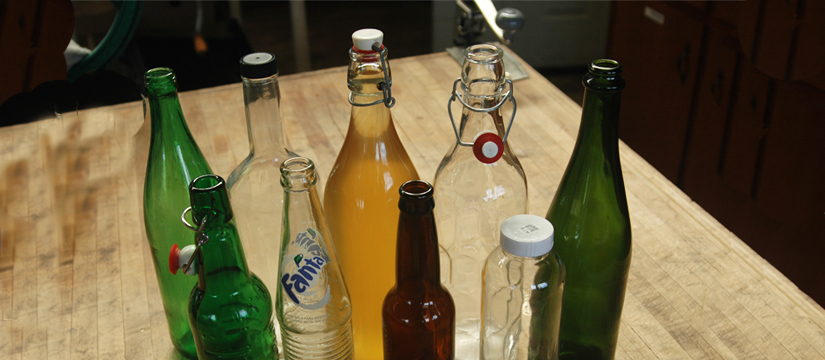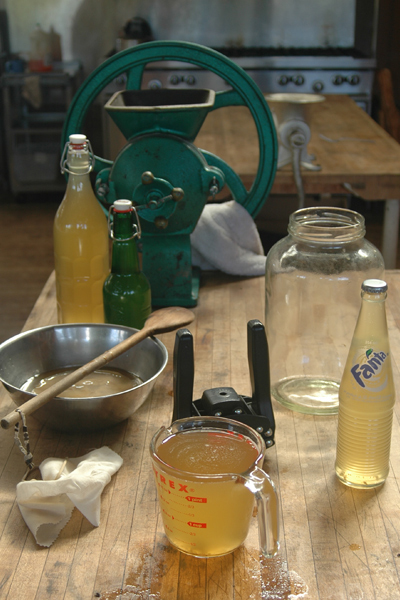(Need the recipe for kombucha? For detailed instructions, visit How to Make Traditional Kombucha)
Kombucha matures—becoming more delicious with age—much like wine. I age mine for two weeks at the very minimum and have found that the flavor begins to truly bloom around two months. Bottling and aging kombucha is not a difficult process as long as you have quality bottles and some patience.
A Word of Caution:
Bottled kombucha can become vigorously carbonated as it ages. If kombucha exceeds the pressure tolerance of its bottle or cap, it will explode. Taking proper precautions will greatly reduce the chance of explosion, but even the most meticulous bottler will lose a bottle occasionally.
Always follow these precautions:
*Never use caps or other parts made from aluminum or other materials that may deform under pressure.
*Never use bottles that are chipped, cracked, or obviously flawed.
*Bottles with thick glass, textures, and a narrow diameter are less likely to break.
*Never add more than a tiny bit of sugar, fruit, or other ingredients to kombucha that is about to be bottled and aged as it may increase carbonation to explosive levels.
*Keep bottled kombucha in a cool place like a basement or cellar.
*Never shake bottled kombucha.
*Store kombucha bottles in closed boxes or cupboards so that no one can be hurt if they explode.
Choosing a Bottle
If a bottle was designed for a carbonated beverage, it will probably work for kombucha. Here are some recommended bottle types…
Pry-off Bottles:
Used glass Pop and Beer bottles are plentiful and free! Collect your own, ask friends and bars, or take them from recycle bins. You’ll need new caps, which cost about $.20 each, and a bottle capper to attach them ($20 – $40). Those can be purchased online or at a brewing supply store. Just watch out for one thing: Bottles made in the US are made of thin glass because they are not normally reused. If they were made for carbonated beverages, then they will hold some pressure but not a lot—just be careful! For safety and character, try to collect bottles from countries that normally reuse bottles—such as Mexican Coke. Pry-off bottles with twist off caps cannot be recapped with a basic capper.
Plastic Pop Bottles:
Some people reuse these because they are completely free and readily available. I don’t prefer them because I tried it once and my kombucha was so carbonated that the bottle began to stretch and inflate like a balloon. Also, after the BPA scandal I just prefer to avoid plastics whenever possible. Still, this may be a good option for a beginner who isn’t ready to invest money in better materials.
Swing Top Bottles:
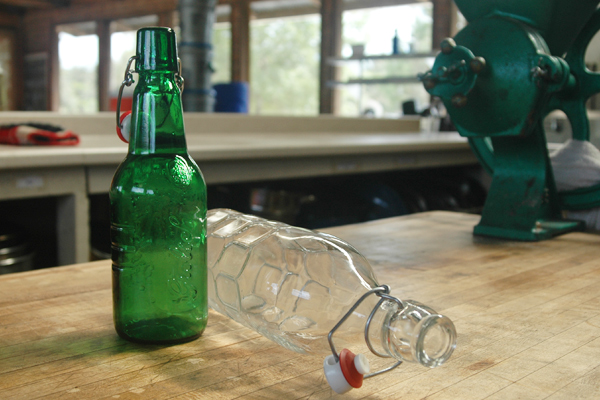
These are my favorite! They’re classy, strong, and can be reused for years. Plus, they are less likely to explode because excessive pressure can push the rubber gasket to the side to vent pressure safely. But you are not likely to find them for free. It is usually cheapest to buy them in the form of imported beverages. Make sure that the wires are not easily bent.
Champagne Bottles:
These are designed specifically to hold tremendous amounts of pressure. They work great for kombucha as long as the cork is in good shape and the wire is properly secured.
Glass Bottles with Screw-on Caps:
If the glass is thick and the cap is made of strong plastic or steel, these can work. Never use an aluminum cap because it will easily deform under pressure and shoot off like a rocket. I learned this by experience. It put a hole in the ceiling!
The Process
Kombucha is primarily fermented with the mother in an aerobic (with oxygen) environment. This converts sugars into acids. When your kombucha has reached a level of sweetness and sourness that you like, it is ready to be bottled. In the bottle, the kombucha will continue to ferment in an anaerobic (without oxygen) environment. Anaerobic fermentation produces carbonation, richer flavor, and a negligible amount of alcohol.
1. With clean hands, place the kombucha mother in a bowl along with enough kombucha to start a new batch. Set these aside.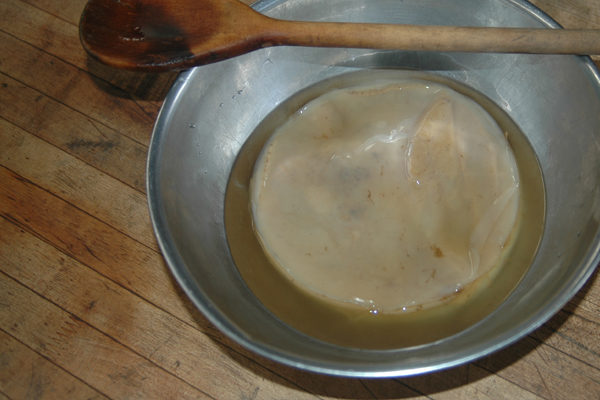
2. There should be some sediment at the bottom of the brewing vessel. This is settled bacteria and yeast from the kombucha culture and it is found in any unfiltered kombucha. You want this in your bottles, so stir it up with a wooden spoon before bottling.
3. Fill your bottles with kombucha so that there is about ¼ inch of air at the top of the bottle. Too much air in the bottle will allow the kombucha to continue aerobic fermentation—making it more sour. It will also impair the carbonation process. Air can be compressed greatly, while water cannot be compressed at all, so the less air there is present in the bottle, the more carbon dioxide will be forced into the kombucha to carbonate it. Do leave a little air in the bottle to reduce the chance of the bottle exploding and so that if the bottle seeps it will seep air rather than kombucha.

4. Cap the bottle. If you are using screw-on caps, make them tight but not excessively tight.
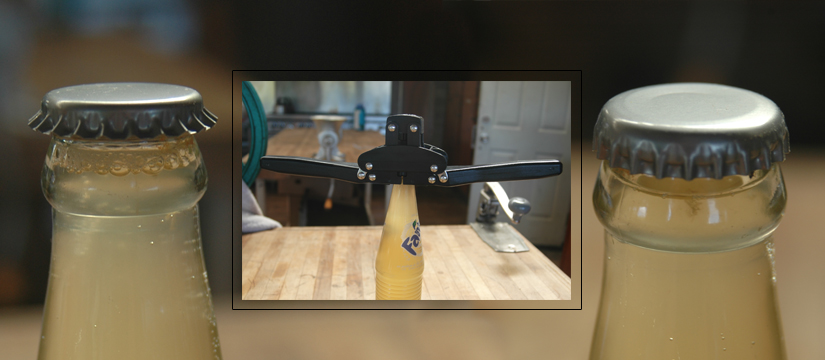
5. Rinse, dry, and label the bottles. I typically write the date on the caps with a dry erase marker. I keep more detailed records in a notebook.
6. Age the kombucha in a cool, dark place like a cellar or basement. Keep it in the range of 40°-65°F. At lower temperatures it will age more slowly and probably mature better. At higher temperatures it will carbonate quickly but the flavor will not mature as well. Lower temperatures greatly reduce the chance of bottles exploding. Keep bottles in a box or cupboard to contain any possible explosions and do not store them above anything that could be damaged by getting wet.
7. Carbonation typically develops in 2-4 weeks. The flavor will mature for several months. How it ages will depend on many variables including: ingredients, sugar and acid content, cultures, temperature, humidity, barometric pressure, and time. The possibilities are as complex as any fermented drink. My kombucha tends to get better for up to 4 or 5 months. After that, the flavor and carbonation begin to degrade.
If your kombucha consistently fails to carbonate, it probably needs more sugar. Some people add a little sugar or fruit for this purpose immediately before bottling. I do not recommend this. Most of my bottles that have exploded were a result of this. Instead, try bottling your kombucha a little sooner than usual or add more sugar before aerobic fermentation.
post by Andrew Hillmer

